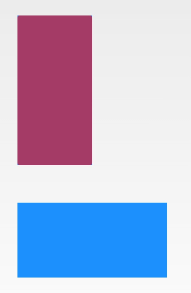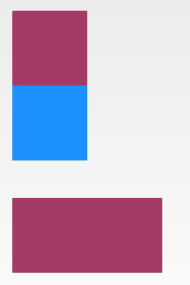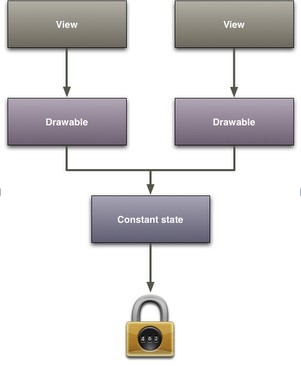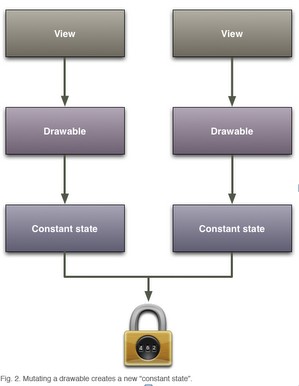Android:关于Drawable的缓存机制应该了解的知识
2017-06-15 13:05
706 查看
我的博客原文地址
首先贴出UI布局文件,这里放了两个
看下面的效果,因为第二个我们没有设置前景图片,因此会现实背景图片。这个很正常,我们不会有什么疑问。

看一下效果图,第一个图片的现实效果和实例1变的不一样了,你也许会感觉这个很正常,因为同一个

看一下效果图,这下显示正常了,这个也可以理解,两个不同的

看下面效果图,奇怪的现象发生了,第一个图片也变成半透明的了,为什么呢?

问题1:为什么设置第二个图片的 alpha 会对第一个图片有影响?
看下面效果图,现在正常了。

问题2:
这样两个图片也能正常显示出来了。

修改一下最后一行代码:
这样的效果仍然是两个图片都是半透明的。
也需要调用
问题3:
有下面打印:
那么,
两个完全不同的
在
这里会从
再直接往下看,
下来看一下
现在我们知道了,
在
那么我们
为了验证这个结论,我们添加打印:
打印如下:
它们确实是指向同一个对象的。
它们的关系可以用下图表示:

我们先来看一下
在
它们的关系可以用下图表示:

注意: mutate操作是不可逆转的,已经调用过
经过上面的源码分析,这个很容易就理解了,它就是获得
这个和重新调用
这就要附带分析一下
我们从
在
在
为了验证这个结论,我们在实例3代码基础上,添加一些Log。
打印如下:
它们的
问题演示
下面我们通过一个实例来演示一个我们在使用Drawable过程中经常会遇到的一个问题。首先贴出UI布局文件,这里放了两个
ImageView,它们的寬高不一样,而且对他们加以蓝色的背景。
<LinearLayout xmlns:android="http://schemas.android.com/apk/res/android" xmlns:mz="http://schemas.android.com/apk/res-auto" android:id="@+id/root" android:layout_width="match_parent" android:layout_height="wrap_content" android:padding="40dp" android:orientation="vertical"> <ImageView android:id="@+id/first" android:layout_width="100dp" android:layout_height="200dp" android:scaleType="fitXY" android:background="#1E90FF"/> <ImageView android:id="@+id/second" android:layout_width="200dp" android:layout_height="100dp" android:layout_marginTop="50dp" android:scaleType="fitXY" android:background="#1E90FF"/> </LinearLayout>
实例1
首先我们给第一个ImageView设置一个显示图片。
final BitmapDrawable firstDrawable = (BitmapDrawable) getResources() .getDrawable(R.drawable.test_mutate); mFirstImage = (ImageView) findViewById(R.id.first); mSecondImage = (ImageView) findViewById(R.id.second); mFirstImage.setImageDrawable(firstDrawable);
看下面的效果,因为第二个我们没有设置前景图片,因此会现实背景图片。这个很正常,我们不会有什么疑问。

实例2
接下来我们在原来代码的基础上添加下面代码,为第二个ImageView设置图片。
...... mSecondImage.setImageDrawable(firstDrawable);
看一下效果图,第一个图片的现实效果和实例1变的不一样了,你也许会感觉这个很正常,因为同一个
Drawable对象设置给两个大小不同的
ImageView,第二个尺寸改变以后第一个也跟着改变了。

实例3
那么我们再实例化一个Drawable对象设置给第二个
ImageView。
final BitmapDrawable firstDrawable = (BitmapDrawable) getResources() .getDrawable(R.drawable.test_mutate); final BitmapDrawable secondDrawable = (BitmapDrawable) getResources() .getDrawable(R.drawable.test_mutate); mFirstImage = (ImageView) findViewById(R.id.first); mSecondImage = (ImageView) findViewById(R.id.second); mFirstImage.setImageDrawable(firstDrawable); mSecondImage.setImageDrawable(secondDrawable);
看一下效果图,这下显示正常了,这个也可以理解,两个不同的
Drawable对象设置给不同的
ImageView,他们互不干涉。那么真的是这样的吗?再接着往下面看。

实例4
我们在上面的代码的基础上把第二个Drawable的 alpha 设置为15 0 。
...... secondDrawable.setAlpha(150);
看下面效果图,奇怪的现象发生了,第一个图片也变成半透明的了,为什么呢?

问题1:为什么设置第二个图片的 alpha 会对第一个图片有影响?
实例5
你也许听说过mutate()的作用,那么现在我们改一下代码:
...... secondDrawable.mutate().setAlpha(150);
看下面效果图,现在正常了。

问题2:
mutate()方法是做什么的?
实例6
下面我们再对代码稍作修改:final BitmapDrawable firstDrawable = (BitmapDrawable) getResources() .getDrawable(R.drawable.test_mutate); mFirstImage = (ImageView) findViewById(R.id.first); mSecondImage = (ImageView) findViewById(R.id.second); mFirstImage.setImageDrawable(firstDrawable); mSecondImage.setImageDrawable(firstDrawable.getConstantState().newDrawable());
这样两个图片也能正常显示出来了。

修改一下最后一行代码:
Drawable drawable = firstDrawable.getConstantState().newDrawable(); mSecondImage.setImageDrawable(drawable); drawable.setAlpha(150);
这样的效果仍然是两个图片都是半透明的。
也需要调用
drawable.mutate().setAlpha(150);才能使第二个半透明,第一个没有半透明。
问题3:
Drawable.getConstantState().newDrawable()又是怎么回事?
问题分析
首先通过实例3我们可以得到这样的结论:分别两次调用getResources().getDrawable(R.drawable.test_mutate)肯定不是指向同一个对象的。为了验证真实性,我们添加Log。
Log.e("Test","firstDrawable = "+firstDrawable+", secondDrawable = "+secondDrawable);有下面打印:
3110 3110 E Test : firstDrawable = android.graphics.drawable.BitmapDrawable@3109294, secondDrawable = android.graphics.drawable.BitmapDrawable@d2fb13d
那么,
firstDrawable和
secondDrawable肯定不是指向同一个对象了。
问题1
我们来分析问题1为什么设置第二个图片的 alpha 会对第一个图片有影响?两个完全不同的
ImageView因为设置了资源id相同的图片就产生了关联,现在我们可以猜想,
firstDrawable和
secondDrawable肯定存在某种联系的。此时我们可能立刻想到为了优化性能,Android内部是不是针对相同的资源使用了同一份位图信息呢?是不是有什么缓存机制呢?带着这个疑问我们先来分析
Resources的源码。
在
Resources类中,我们找到了
loadDrawable()方法:
...
final DrawableCache caches;
...
final Drawable cachedDrawable = caches.getInstance(key, theme);
if (cachedDrawable != null) {
return cachedDrawable;
}
...这里会从
caches里面获取曾经加载过的资源,如果找到就直接返回缓存。具体这个缓存是怎么放进去的我们就不再详细分析了。前面我们也说了,
firstDrawable和
secondDrawable是不同的对象,那他们在这个缓存里肯定也不是同一个
Drawable了。
再直接往下看,
DrawableCache是什么呢?
DrawableCache继承自
ThemedResourceCache。
下来看一下
DrawableCache的
getInstance()方法:
public Drawable getInstance(long key, Resources.Theme theme) {
final Drawable.ConstantState entry = get(key, theme);
if (entry != null) {
return entry.newDrawable(mResources, theme);
}
return null;
}现在我们知道了,
caches里面缓存的不是
Drawable对象,而是
Drawable.ConstantState对象。
public static abstract class ConstantState {
public abstract Drawable newDrawable();
public Drawable newDrawable(Resources res) {
return newDrawable();
}
public Drawable newDrawable(Resources res, Theme theme) {
return newDrawable(null);
}
public abstract int getChangingConfigurations();
public int addAtlasableBitmaps(Collection<Bitmap> atlasList) {
return 0;
}
protected final boolean isAtlasable(Bitmap bitmap) {
return bitmap != null && bitmap.getConfig() == Bitmap.Config.ARGB_8888;
}
public boolean canApplyTheme() {
return false;
}
}ConstantState类是一个抽象类,
BitmapDrawable.BitmapState便是它的实现类之一。由于
getResources().getDrawable(R.drawable.test_mutate)得到的是
BitmapDrawable,那么我们就重点分析这个类。
final static class BitmapState extends ConstantState {
final Paint mPaint;
int[] mThemeAttrs = null;
Bitmap mBitmap = null;
ColorStateList mTint = null;
Mode mTintMode = DEFAULT_TINT_MODE;
int mGravity = Gravity.FILL;
float mBaseAlpha = 1.0f;
Shader.TileMode mTileModeX = null;
Shader.TileMode mTileModeY = null;
int mTargetDensity = DisplayMetrics.DENSITY_DEFAULT;
boolean mAutoMirrored = false;
int mChangingConfigurations;
boolean mRebuildShader;
BitmapState(Bitmap bitmap) {
mBitmap = bitmap;
mPaint = new Paint(DEFAULT_PAINT_FLAGS);
}
BitmapState(BitmapState bitmapState) {
mBitmap = bitmapState.mBitmap;
mTint = bitmapState.mTint;
mTintMode = bitmapState.mTintMode;
mThemeAttrs = bitmapState.mThemeAttrs;
mChangingConfigurations = bitmapState.mChangingConfigurations;
mGravity = bitmapState.mGravity;
mTileModeX = bitmapState.mTileModeX;
mTileModeY = bitmapState.mTileModeY;
mTargetDensity = bitmapState.mTargetDensity;
mBaseAlpha = bitmapState.mBaseAlpha;
mPaint = new Paint(bitmapState.mPaint);
mRebuildShader = bitmapState.mRebuildShader;
mAutoMirrored = bitmapState.mAutoMirrored;
}
@Override
public boolean canApplyTheme() {
return mThemeAttrs != null || mTint != null && mTint.canApplyTheme();
}
@Override
public int addAtlasableBitmaps(Collection<Bitmap> atlasList) {
if (isAtlasable(mBitmap) && atlasList.add(mBitmap)) {
return mBitmap.getWidth() * mBitmap.getHeight();
}
return 0;
}
@Override
public Drawable newDrawable() {
return new BitmapDrawable(this, null);
}
@Override
public Drawable newDrawable(Resources res) {
return new BitmapDrawable(this, res);
}
@Override
public int getChangingConfigurations() {
return mChangingConfigurations
| (mTint != null ? mTint.getChangingConfigurations() : 0);
}
}在
newDrawable()方法里面返回的是一个新的
BitmapDrawable对象,但是所有相同资源的
BitmapDrawable对象共用同一个
BitmapState对象。我们注意到
BitmapState的
mBitmap属性,这也验证了前面的猜想,它们共用同一个
Bitmap。
private BitmapDrawable(BitmapState state, Resources res) {
mBitmapState = state;
updateLocalState(res);
}
@Override
public void setAlpha(int alpha) {
final int oldAlpha = mBitmapState.mPaint.getAlpha();
if (alpha != oldAlpha) {
mBitmapState.mPaint.setAlpha(alpha);
invalidateSelf();
}
}那么我们
setAlpha()操作实际改变的是
mBitmapState的属性值,这也就不难理解问题1了,因为它们用的是同一个
BitmapState对象。
为了验证这个结论,我们添加打印:
Log.e("Test","firstDrawable = "+firstDrawable.getConstantState()+", secondDrawable = "+secondDrawable.getConstantState());打印如下:
4433 4433 E Test : firstDrawable = android.graphics.drawable.BitmapDrawable$BitmapState@3109294, secondDrawable = android.graphics.drawable.BitmapDrawable$BitmapState@3109294
它们确实是指向同一个对象的。
它们的关系可以用下图表示:

问题2
接下来再来分析问题2:mutate()方法是做什么的?
我们先来看一下
Drawable中对这个方法的解释:
/**
* Make this drawable mutable. This operation cannot be reversed. A mutable
* drawable is guaranteed to not share its state with any other drawable.
* This is especially useful when you need to modify properties of drawables
* loaded from resources. By default, all drawables instances loaded from
* the same resource share a common state; if you modify the state of one
* instance, all the other instances will receive the same modification.
*
* Calling this method on a mutable Drawable will have no effect.
*
* @return This drawable.
* @see ConstantState
* @see #getConstantState()
*/
public Drawable mutate() {
return this;
}mutate()返回的
Drawable对象不再与同资源的其他
Drawable共用 state,那么它的属性改变后就不再影响其他的
Drawable了。
在
BitmapDrawable的
mutate()方法里面确实又新建了一个
BitmapState对象。
/**
* A mutable BitmapDrawable still shares its Bitmap with any other Drawable
* that comes from the same resource.
*
* @return This drawable.
*/
@Override
public Drawable mutate() {
if (!mMutated && super.mutate() == this) {
mBitmapState = new BitmapState(mBitmapState);
mMutated = true;
}
return this;
}它们的关系可以用下图表示:

注意: mutate操作是不可逆转的,已经调用过
mutate()方法的
BitmapDrawable对象再调用
mutate()是不起作用的。这点在代码中可以清楚的看到。
问题3
记下来分析问题3:Drawable.getConstantState().newDrawable()又是怎么回事?
经过上面的源码分析,这个很容易就理解了,它就是获得
Drawable的
ConstantState来重新实例化一个
Drawable,两个
Drawable还是共用一个
ConstantState。
这个和重新调用
getResources().getDrawable(R.drawable.test_mutate)原理是一样的。
附加问题
那为什么设置 alpha 两个图片互有影响,而在实例3中第二个Drawable大小尺寸改变却没有影响呢?
这就要附带分析一下
ImageView的
ScaleType原理。
我们从
ImageView.setImageDrawable开始分析,这个方法的调用流程如图:
├── ImageView.setImageDrawable └── ImageView.updateDrawable └── configureBounds()
private void configureBounds() {
...
if (dwidth <= 0 || dheight <= 0 || ScaleType.FIT_XY == mScaleType) {
mDrawable.setBounds(0, 0, vwidth, vheight);
mDrawMatrix = null;
}
...
}
@Override
protected void onDraw(Canvas canvas) {
super.onDraw(canvas);
...
if (mDrawMatrix == null && mPaddingTop == 0 && mPaddingLeft == 0) {
mDrawable.draw(canvas);
} else {
int saveCount = canvas.getSaveCount();
canvas.save();
if (mCropToPadding) {
final int scrollX = mScrollX;
final int scrollY = mScrollY;
canvas.clipRect(scrollX + mPaddingLeft, scrollY + mPaddingTop,
scrollX + mRight - mLeft - mPaddingRight,
scrollY + mBottom - mTop - mPaddingBottom);
}
canvas.translate(mPaddingLeft, mPaddingTop);
if (mDrawMatrix != null) {
canvas.concat(mDrawMatrix);
}
mDrawable.draw(canvas);
canvas.restoreToCount(saveCount);
}
}在
configureBounds()里面根据不同的
ScaleType会进行不同的变换,包括设置绘制边界、缩放、位移、绘制是的矩阵变换等等。
在
onDraw()方法中再把这个
Drawable绘制到
Canvas上,这些改变变化的只是
Drawable本身,而对
ConstantState不会有改变。
为了验证这个结论,我们在实例3代码基础上,添加一些Log。
public void refresh(View v){
Log.e("Test","1 rect1 = "+mFirstImage.getDrawable().getBounds());
Log.e("Test","2 rect2 = "+mSecondImage.getDrawable().getBounds());
}打印如下:
21313 21313 E Test : 1 rect1 = Rect(0, 0 - 200, 400) 21313 21313 E Test : 2 rect2 = Rect(0, 0 - 400, 200)
它们的
Drawable.mBounds是不同的。
参考文章
https://android-developers.googleblog.com/2009/05/drawable-mutations.html相关文章推荐
- 关于Android新手应该先了解的知识
- Android中关于Volley的使用(八)缓存机制的深入认识
- 关于Android图片分辨率应该放到哪个文件夹的问题(drawable-hdpi......)
- 关于Android屏幕适配应该知道的一些知识
- Android things:你应该了解的Android Things知识
- Android的Drawable缓存机制源码分析
- 关于Android屏幕适配应该知道的一些知识
- Android中关于Volley的使用(五)缓存机制的深入认识
- Android中关于Volley的使用(八)缓存机制的深入认识
- 关于建立分布式应用程序应该了解的知识
- Android中关于Volley的使用(八)缓存机制的深入认识
- Android的Drawable缓存机制源码分析
- 关于Android strings.xml-你应该了解的几个原则
- Android的Drawable缓存机制源码分析
- 关于Android图片分辨率应该放到哪个文件夹的问题(drawable-hdpi......)
- Android中关于Volley的使用(八)缓存机制的深入认识
- 为SSD编程(6):总结—每个程序员都应该了解的关于固态硬盘的知识
- 关于Android strings.xml-你应该了解的几个原则
- 关于电脑设备BIOS的八种最应该了解的知识
